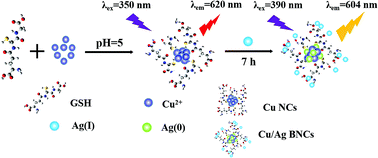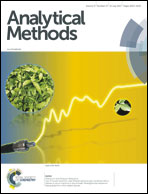Synthesis of highly luminescent Cu/Ag bimetal nanoclusters and their application in a temperature sensor†
Abstract
Bimetal nanoclusters (BNCs) have attracted great attention due to their cooperative electronic, optical, and catalytic properties. In this study, the highly luminescent Cu/Ag BNCs were prepared based on the weakly luminescent glutathione (GSH)-capped Cu NCs for the first time. After the introduction of a certain amount of Ag+, a 9-fold enhancement of the luminescence intensity was obtained from GSH-protected Cu/Ag BNCs. The luminescence emission peak was blue shifted from 620 nm (red emission) to 604 nm (orange-yellow emission). The Cu/Ag BNCs exhibited an average size of around 1.4 ± 0.2 nm, as observed from a thorough analysis of transmission electron microscopy data. The as-prepared Cu/Ag BNCs exhibited excellent anti-interference performance against various metal ions. In addition to the intrinsic optical properties, the Cu/Ag BNCs were employed as a temperature sensor by virtue of the luminescence intensity of Cu/Ag BNCs responding sensitively to temperature fluctuating in the range of 4–55 °C.



 Please wait while we load your content...
Please wait while we load your content...